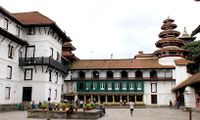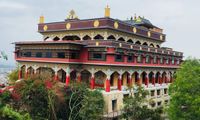Boudhanath Stupa
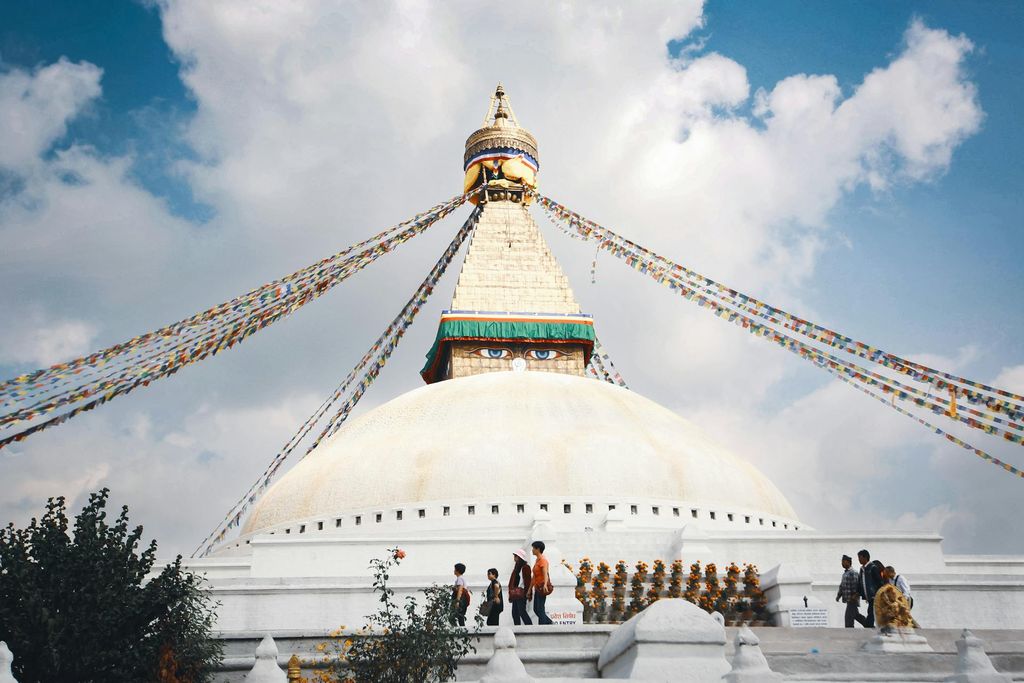
About
Nestled in the heart of Kathmandu, Boudhanath Stupa is one of the world’s largest and most sacred Buddhist monuments. A UNESCO World Heritage Site, it stands as a timeless symbol of peace, compassion, and enlightenment. Surrounded by vibrant monasteries, fluttering prayer flags, and the rhythmic hum of monks chanting, this majestic white dome radiates spiritual energy day and night. Whether you’re here to meditate, explore Tibetan culture, or simply soak in the tranquil atmosphere, Boudhanath offers a profound glimpse into Nepal’s living spiritual heritage — a place where faith and humanity unite beneath the all-seeing eyes of Buddha.
Locate Us
Nearby Attractions
Amid the rhythmic chants of monks and the gentle flutter of prayer flags, Boudhanath Stupa stands as a symbol of peace and compassion in the heart of Kathmandu. This sacred monument, one of the largest stupas in the world, is not just a religious site — it’s a living, breathing embodiment of Nepal’s spiritual soul.
Located about 8 kilometers east of central Kathmandu, Boudhanath welcomes thousands of visitors daily — monks in crimson robes, pilgrims spinning prayer wheels, and travelers captivated by the energy of devotion that fills the air. The scent of incense mingles with butter lamps, creating an atmosphere of calm that feels timeless.
Recognized as a UNESCO World Heritage Site since 1979, Boudhanath has long been the center of Tibetan Buddhism in Nepal. Surrounding the white dome are dozens of monasteries, meditation centers, and rooftop cafés offering panoramic views of the stupa’s iconic all-seeing eyes of Buddha, gazing in every direction, symbolizing awareness and wisdom.
Whether you come to meditate, photograph the golden spire against the Himalayan sky, or simply soak in the spiritual energy, Boudhanath Stupa is an experience that stays with you long after you leave.
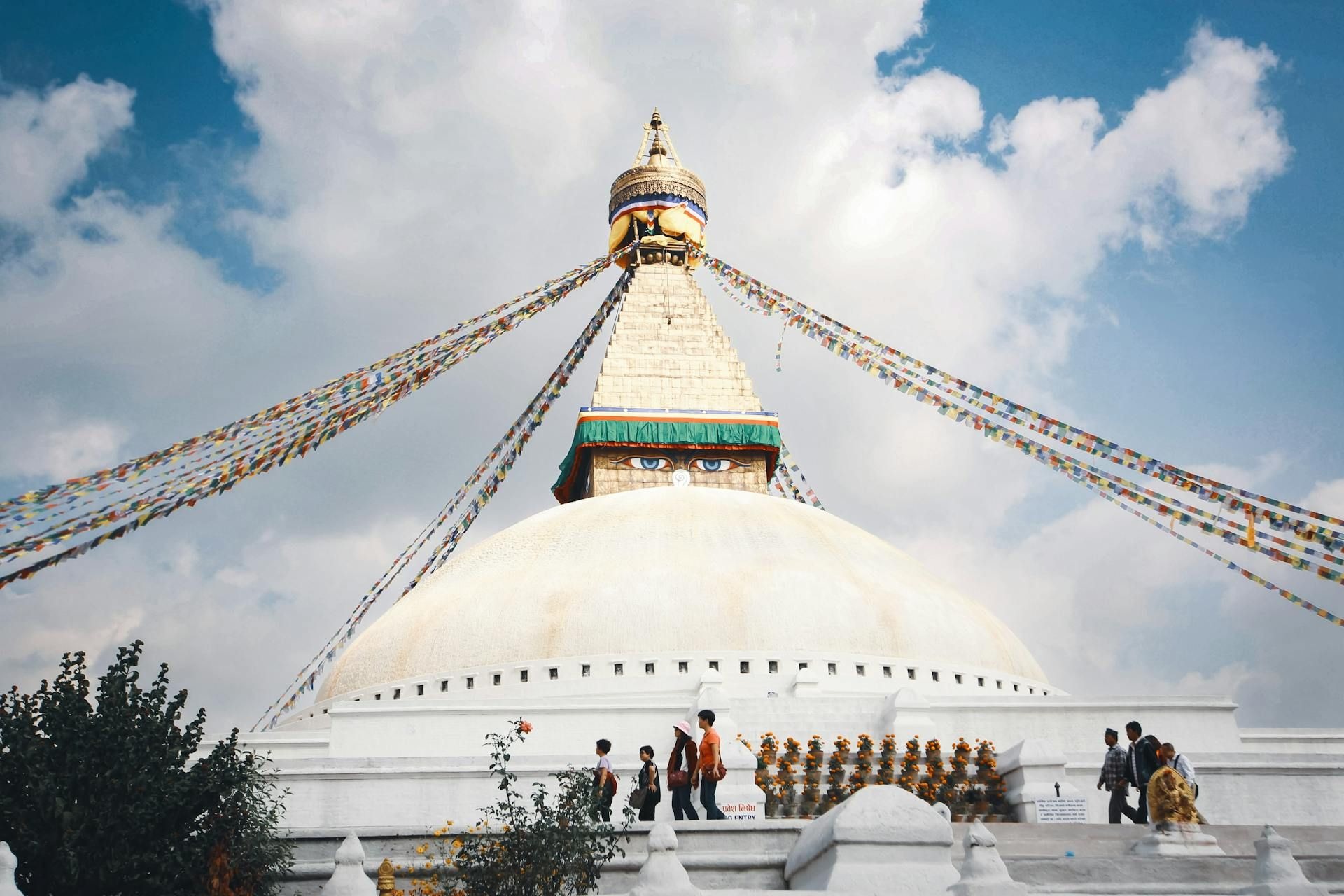
Highlights of Boudhanath Stupa
- UNESCO World Heritage Site: One of the largest and most sacred Buddhist stupas in the world, symbolizing peace and compassion.
- Spiritual Atmosphere: Constant sound of prayer wheels, chanting monks, and fluttering prayer flags create a deeply serene vibe.
- Cultural Hub: Center of Tibetan Buddhism in Nepal, surrounded by monasteries, meditation centers, and artisan shops.
- Kora Ritual: Witness or join devotees walking clockwise around the stupa, spinning prayer wheels and chanting mantras.
- Stunning Architecture: White dome, golden spire, and Buddha’s all-seeing eyes make it one of Nepal’s most photogenic landmarks.
- Festivals and Ceremonies: Experience Losar (Tibetan New Year), Buddha Jayanti, and full-moon butter-lamp rituals.
- Rooftop Cafés: Enjoy tea and panoramic views from cozy cafés overlooking the stupa — especially magical at sunset.
History and Legends
The story of Boudhanath is as fascinating as its presence is powerful. Steeped in myth, legend, and centuries of history, it stands as a beacon of faith and resilience.
The Origin Story
According to legend, during the Licchavi period (5th century CE), a humble woman known as Jyajima or “Aunty” asked the king for permission to build a stupa to enshrine relics of the Buddha. Granted land, she constructed the great dome with the help of her four sons, each of whom later founded important monasteries in Tibet. This tale symbolizes how compassion and devotion can create something extraordinary, transcending class and time.
Historical Timeline
Boudhanath’s strategic location on the ancient trade route between Tibet and Nepal made it a resting place for traders and pilgrims. Over time, it became a spiritual hub for Tibetan merchants traveling with caravans of wool and salt. When Tibetans fled their homeland after 1959, many settled around Boudha, revitalizing the stupa and turning the area into a thriving center of Tibetan culture and learning.
Today, Boudhanath remains a sacred site for Tibetan Buddhists, Nepali Buddhists, and global spiritual seekers, continuing its legacy as a place where history, faith, and humanity converge.
Architectural Marvel
Standing at a height of 36 meters, Boudhanath Stupa is one of the most striking architectural wonders in Nepal. Its design is not merely artistic — every element holds deep symbolic meaning rooted in Buddhist philosophy.
The Dome and Eyes of Buddha
The massive white dome represents the vastness of the universe, while the square tower above it features the all-seeing eyes of Buddha, painted on all four sides to signify awareness and compassion. Between the eyes lies a curly symbol resembling a question mark — the Nepali number “1,” representing unity and the single path to enlightenment.
The Mandala Layout
The stupa’s base follows a mandala design, reflecting the Buddhist concept of cosmic harmony. The 13 steps ascending the tower symbolize the stages a person must pass through to attain nirvana. Encircling the stupa are 108 small niches containing prayer wheels — a sacred number in Buddhism — which pilgrims spin as they walk clockwise around the monument, reciting mantras for peace and good karma.
Prayer Flags and Mani Wheels
Above the stupa, colorful prayer flags stretch across the sky, carrying blessings of compassion and wisdom with every flutter in the wind. These flags — in hues of blue, white, red, green, and yellow — represent the five elements of nature and the interconnectedness of life. The sound of spinning mani wheels, each inscribed with “Om Mani Padme Hum,” adds a soothing rhythm to the surroundings, turning Boudha into a sanctuary of sound and spirit.
Cultural and Spiritual Significance
Boudhanath isn’t just a monument to admire — it’s a living spiritual ecosystem, sustained by centuries of faith and devotion.
Pilgrimage and Kora Tradition
At dawn and dusk, devotees from all walks of life perform Kora, the ritual of walking clockwise around the stupa while chanting prayers or silently reflecting. The rhythmic shuffle of feet, spinning of prayer wheels, and murmur of mantras create an atmosphere of profound serenity.
Daily Monastic Chants and Offerings
Around the stupa, monasteries such as Shechen, Kopan, and Ka-Nying Shedrub Ling host daily prayers and ceremonies. The air vibrates with the deep hum of Tibetan horns and chanting monks, creating a sensory experience that connects visitors to something far greater than themselves.
Boudha’s Role in Tibetan Refugee Culture
After the 1959 Tibetan exodus, Boudhanath became a refuge for displaced monks, artists, and teachers who rebuilt their lives around the stupa. This cultural revival transformed Boudha into the heart of Tibetan Buddhism in exile, where traditions of art, meditation, and compassion continue to flourish.
Things to Do at Boudhanath Stupa
Boudhanath isn’t just a place to visit — it’s a place to experience. Every corner offers a chance to slow down, reflect, and connect with the rhythm of spiritual life.
Circumambulation and Meditation
One of the most meaningful things you can do is join the pilgrims performing the kora — the clockwise circumambulation of the stupa. Locals, monks, and travelers walk together in silent meditation or soft chanting, spinning the prayer wheels as they go. If you rise early, you’ll see the first rays of sunlight striking the golden spire while incense fills the air — a truly unforgettable sight.
Monastery Visits
The area surrounding Boudhanath is dotted with magnificent monasteries, each offering its own charm. Shechen Monastery is renowned for its vibrant murals and community of monks dedicated to preserving ancient Buddhist teachings. Kopan Monastery, a short drive away, offers meditation retreats for visitors eager to deepen their spiritual understanding. Ka-Nying Shedrub Ling Monastery, one of the largest near the stupa, welcomes visitors to witness daily prayers and teachings.
Rooftop Cafés and Viewpoints
Boudhanath’s charm extends upward — quite literally. Many of the surrounding buildings feature rooftop cafés where travelers can sip Nepali tea or coffee while soaking in panoramic views of the stupa below. During sunset, when the dome glows gold and the sky turns crimson, it’s pure magic.
Shopping for Souvenirs and Thangka Art
The narrow lanes around the stupa are filled with small shops selling handcrafted items, prayer beads, singing bowls, and Thangka paintings — intricate artworks depicting Buddhist deities and mandalas. Buying directly from local artisans supports the community and helps preserve their traditional crafts.
Photography Tips
Boudhanath is one of Kathmandu’s most photogenic sites, but it’s also a sacred one. Early mornings and late afternoons offer the best light, but remember to photograph respectfully. Avoid using flash during rituals, and always ask before taking portraits of monks or locals.
Festivals and Events
Throughout the year, Boudhanath transforms into a dazzling center of celebration, prayer, and community.
Losar (Tibetan New Year)
The most vibrant festival at Boudha is Losar, celebrated in February or March. The area bursts into color as locals hang new prayer flags, light butter lamps, and gather for feasts. Monks perform elaborate masked dances known as Cham, symbolizing the victory of wisdom over ignorance.
Buddha Jayanti
This sacred festival marks the birth, enlightenment, and death of Lord Buddha — all believed to have occurred on the same day. The stupa is adorned with thousands of butter lamps, and pilgrims from across Nepal and Tibet come to offer prayers. It’s one of the most visually stunning times to visit, with devotees circling the stupa all day and night.
Full Moon Ceremonies
Every full moon, Boudha glows under a sea of butter lamps. Locals light candles around the base of the stupa, chanting mantras late into the night. For visitors, joining this ceremony — even as a silent observer — can be a deeply moving experience.
Best Time to Visit Boudhanath Stupa
Boudha is beautiful in every season, but some times of day and year enhance the experience.
Morning Serenity
If you want to see Boudhanath at its most tranquil, arrive at dawn. Monks and devotees begin their prayers, the smell of incense fills the air, and the golden morning light reflects beautifully off the white dome. It’s the perfect time for quiet meditation and photography.
Evening Glow
Evenings at Boudha are a sight to behold. As the sun sets, butter lamps flicker all around the stupa, and the chanting of mantras grows louder. The combination of spiritual energy and visual beauty makes this the most popular time for visitors.
Seasonal Insights
- Autumn (Sept–Nov): Clear skies, ideal weather, and festival season.
- Winter (Dec–Feb): Peaceful atmosphere, crisp air, fewer crowds.
- Spring (Mar–May): Flowers bloom and vibrant festivals take place.
- Monsoon (Jun–Aug): Rainy, but the stupa’s freshness and greenery have their own charm.
How to Reach Boudhanath Stupa
Boudhanath is conveniently located in Kathmandu’s northeastern outskirts, making it easy to reach from almost anywhere in the city.
From Kathmandu
The stupa lies about 8 km from Thamel, the main tourist hub.
- By Taxi: Takes 20–25 minutes depending on traffic; expect to pay around NPR 400–600.
- By Local Bus: Budget-friendly option from Ratna Park or Chabahil; fares under NPR 30.
- Walking: Adventurous travelers sometimes pair visits to Pashupatinath Temple and Boudhanath in a single day’s stroll (about 3 km apart).
Nearest Attractions
- Pashupatinath Temple: Nepal’s most revered Hindu site, located just a short walk away.
- Kapan Monastery: A hilltop retreat offering guided meditation sessions and panoramic valley views.
- Thamel: The bustling heart of Kathmandu, filled with shops, cafés, and tour agencies.
Accommodation Around Boudhanath
Staying near Boudhanath allows you to experience its peaceful energy long after most tourists have left.
Boutique Hotels
Hotels like The Inn at Boudha and Aarya Chaitya Inn combine modern comforts with traditional décor and stupa views. Many boutique hotels offer rooftop terraces perfect for early-morning meditation or evening tea under prayer flags.
Budget Guesthouses
Travelers on a budget can find excellent options like Shambaling Guest House and Hotel Mandala House, both providing clean, cozy rooms and warm Nepali hospitality.
Monastery Stays
For a unique experience, consider staying at a monastery guesthouse. Some monasteries, such as Kopan Monastery, welcome visitors for short meditation retreats — offering a glimpse into monastic life and mindfulness practices.
Travel Tips for Visitors
Visiting Boudhanath Stupa can be both spiritual and educational, but a few tips can help you make the most of your time while respecting local traditions.
Dress Code and Behavior
Boudha is a sacred site, not just a tourist spot. Wear modest clothing — shoulders and knees covered — especially if you plan to enter nearby monasteries. Move clockwise around the stupa as locals do, and avoid loud conversations or disruptive behavior. A gentle smile and respectful silence often go further than words here.
Photography Etiquette
The stupa is one of the most photographed sites in Nepal, but it’s important to remain sensitive.
- Avoid using flash during prayers or ceremonies.
- Always ask permission before photographing monks or devotees.
- Refrain from climbing onto restricted areas for “better angles.”
If you want stunning photos, the early morning light and golden hour before sunset are unbeatable.
Supporting Local Communities
Many of the shops and restaurants around Boudha are family-run or operated by Tibetan refugees. When you buy handcrafted goods, eat in local cafés, or donate to monasteries, you directly support the preservation of culture and livelihoods. Choose eco-friendly souvenirs such as prayer flags, Thangka paintings, and singing bowls made locally rather than mass-produced imports.
Nearby Attractions Around Boudha
Boudhanath sits at the heart of Kathmandu’s spiritual triangle, surrounded by equally fascinating sites within a short distance.
Pashupatinath Temple
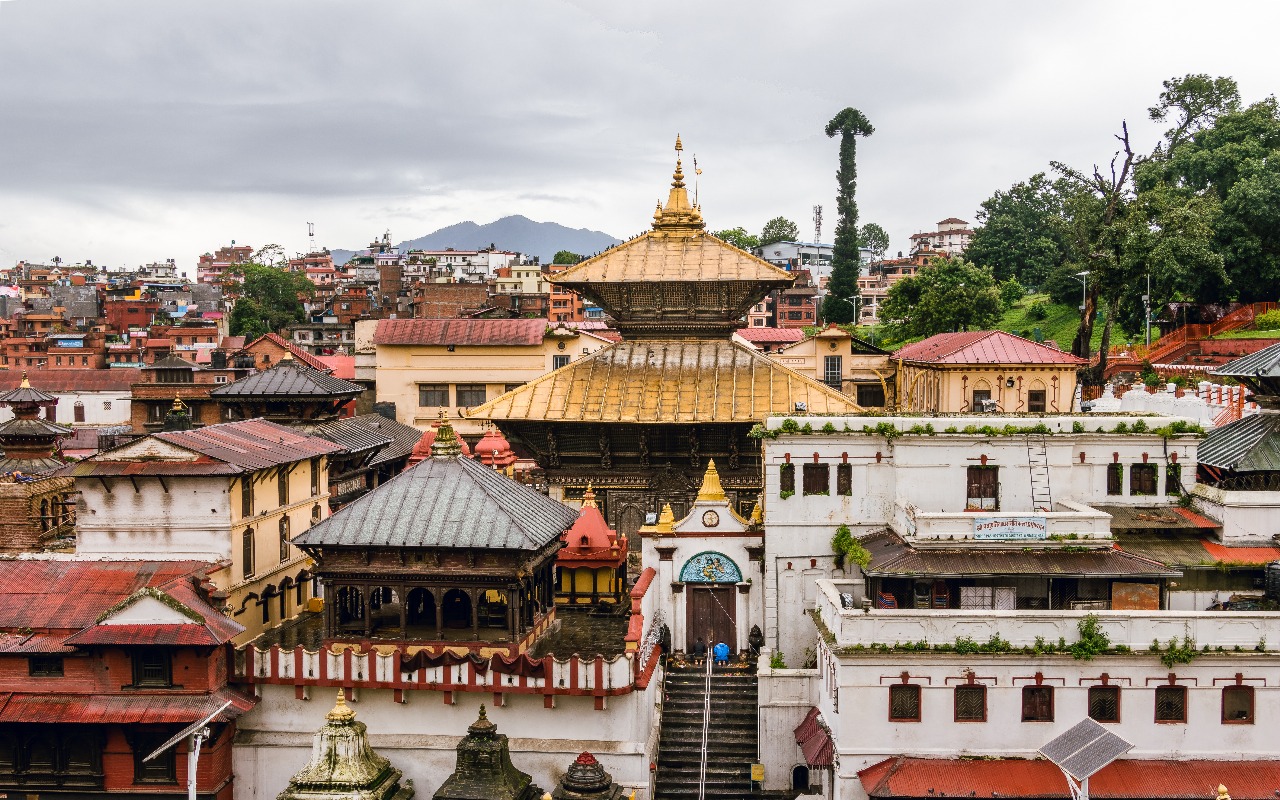
Located just 2 km away, this sacred Hindu temple complex on the banks of the Bagmati River is another UNESCO World Heritage Site. Pilgrims, priests, and sadhus fill the area, offering a captivating glimpse into Nepal’s spiritual diversity. The evening Aarati ceremony at Pashupatinath is one of the most moving rituals to witness.
Kapan Monastery
Perched on a nearby hill, Kapan Monastery is a peaceful retreat known for its meditation courses and panoramic views of the Kathmandu Valley. It’s a perfect place to spend a few quiet hours reflecting after your visit to Boudha.
Thamel
About a 20-minute drive from Boudha, Thamel is Kathmandu’s bustling tourist hub. After immersing yourself in spiritual calm, Thamel’s lively atmosphere offers a contrast — filled with restaurants, bookstores, trekking shops, and music cafés.
Conclusion
Visiting Boudhanath Stupa is far more than ticking off a landmark — it’s a journey into the spiritual heart of Nepal. From the first sight of the golden spire rising above the white dome to the rhythmic spin of prayer wheels beneath fluttering flags, every moment invites calm, reflection, and connection.
Here, centuries of history blend seamlessly with the hum of daily devotion. You’ll see monks chanting in the morning sun, elderly women counting mala beads, and travelers quietly absorbing the serenity of it all. The energy of Boudhanath transcends religion — it’s a universal space of peace where anyone, regardless of faith, can feel at home.
Before you leave, take a final walk around the stupa, watching the evening lights shimmer as prayers float into the sky. It’s said that those who walk the kora with a pure heart leave behind a little of their worries — and carry away a bit of enlightenment.
So whether you’re seeking spiritual renewal, cultural discovery, or simple tranquility, Boudhanath Stupa will leave you touched in ways words can’t fully describe.
Frequently Asked Questions (FAQs)
1. Why is Boudhanath Stupa famous?
Boudhanath Stupa is famous as one of the largest spherical stupas in the world and a major center of Tibetan Buddhism. It’s also revered as a site of enlightenment and peace, attracting monks, pilgrims, and travelers from across the globe.
2. How old is Boudhanath Stupa?
Historians trace the origins of Boudhanath to around the 5th century CE, during Nepal’s Licchavi period. Despite centuries of change and even damage from the 2015 earthquake, it has been lovingly restored and continues to stand as a timeless spiritual landmark.
3. What is the best time to visit Boudhanath Stupa?
The best times are early morning (6–8 AM) and evening (5–7 PM), when the stupa glows in soft light and the air fills with chanting. Seasonally, autumn and spring offer the most pleasant weather for sightseeing and photography.
4. Can visitors enter the stupa?
The interior of the main dome is not open to the public, as it’s considered sacred. However, you can explore the circumambulation path, surrounding monasteries, and rooftop viewpoints for immersive experiences.
5. What should I wear when visiting?
Dress modestly out of respect for the site’s religious nature. Light, comfortable clothing in neutral tones works well. Remove your shoes when entering monasteries or shrines.
6. Is Boudha safe for solo travelers?
Yes — Boudhanath is one of the safest areas in Kathmandu, both day and night. The community is warm, welcoming, and accustomed to visitors from all over the world. As always, use standard travel precautions and keep valuables secure.
Reviews
5.0 1 reviews

Dipesh Pangeni
Nepal, May 2024
Boudhanath Stupa
Boudhanath Stupa is a peaceful and spiritual haven in the heart of Kathmandu. The majestic stupa, with its watchful Buddha eyes, radiates serenity and cultural richness. A perfect place to experience Tibetan Buddhism, enjoy the prayer chants, and soak in the vibrant atmosphere. Truly a must-visit!
